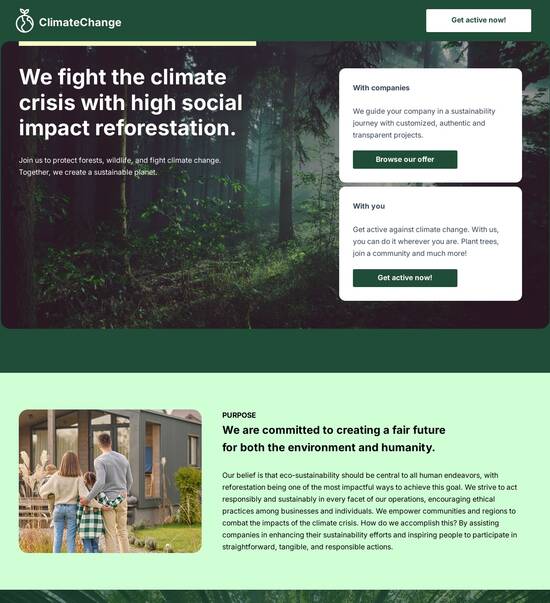
One page website template for crisis management teams
Explore Similar TemplatesAbout template
Set your web page creation project up for success with the one page website template for crisis management teams.
Recommended templates

Easy to build without coding
With the intuitive drag-and-drop builder, anyone on your team can create high-converting pages without any knowledge of code or design. Make enhancements to your landing page with custom widgets using Javascript, HTML/CSS, or third-party scripts.

Multiple layouts for any industry and goal
Select from 500+ landing page layouts built to boost conversions across industry-specific scenarios. Customize them by adjusting fonts, adding images, and generating on-brand content with the AI assistant. Quickly scale with Instablocks® and Global Blocks that you can save, reuse, and update globally.

Loads fast and looks polished on any device
Every template is responsive, which means they present professionally on any device and load blazingly fast with our Thor Render Engine. You can also power them up with Google AMP technology to deliver an unparalleled mobile experience and drive higher conversions.

Robust analytics & experimentation
Get real-time updates and reporting across all your devices, showing the number of visitors, conversions, cost-per-visitor, and cost-per-lead. Launch AI-powered experiments, run A/B tests, and use heatmaps to analyze user behavior, then optimize your landing page to maximize conversions.







Easy to build without coding
With the intuitive drag-and-drop builder, anyone on your team can create high-converting pages without any knowledge of code or design. Make enhancements to your landing page with custom widgets using Javascript, HTML/CSS, or third-party scripts.
Multiple layouts for any industry and goal
Select from 500+ landing page layouts built to boost conversions across industry-specific scenarios. Customize them by adjusting fonts, adding images, and generating on-brand content with the AI assistant. Quickly scale with Instablocks® and Global Blocks that you can save, reuse, and update globally.
Loads fast and looks polished on any device
Every template is responsive, which means they present professionally on any device and load blazingly fast with our Thor Render Engine.
Robust analytics & experimentation
Get real-time updates and reporting across all your devices, showing the number of visitors, conversions, cost-per-visitor, and cost-per-lead. Launch AI-powered experiments, run A/B tests, and use heatmaps to analyze user behavior, then optimize your landing page to maximize conversions.
All the features you need to build lead-generating landing pages
Explore more featuresLearn how to build top-performing landing pages for any goal
FAQs
Leading the way in building high-performing landing pages





Creating an effective one page website template for crisis management teams
Crisis management requires rapid and effective communication. Using Instapage's landing page templates ensures your crisis management team has immediate access to customizable tools that enhance response strategies. This guide will provide insights into designing a coherent one page website template, crucial for managing crises effectively and maximizing outreach.
Understanding the needs of crisis management teams
Crisis management teams require efficient communication channels that adapt to rapidly changing situations. A tailored one page website can serve as a central hub for information dissemination. Opt for elements that prioritize clarity and accessibility, enabling team members and stakeholders to navigate the content without confusion.
- Quick access to updates: Ensure that your template includes sections for real-time updates so team members can stay informed.
- Contact information: Providing clear contact details for team leaders fosters immediate connection during critical situations.
- Resource links: Consolidate essential resources directly on the template to drive rapid action from team members.
Step 1: Template selection and customization
Begin by selecting a template from Instapage’s library that aligns with your crisis management goals and aesthetics. Once chosen, customize this template to highlight the most relevant information for your team and stakeholders.
Step 2: Incorporating critical features
Correctly implemented features can significantly improve your template's usability. Focus on incorporating critical components that enhance the team's crisis response capabilities.
- Real-time notifications: Utilize features that allow for live updates and immediate alerts to keep your audience aware of ongoing developments.
- Engagement elements: Integrate forms or chatbots for immediate feedback or questions from team members.
- Visual aids: Use graphics to represent data clearly, aiding in quicker comprehension of the situation.
Step 3: Testing and optimizing your template
Testing your one page template with potential users ensures that all necessary information is easily accessible. Gather performance metrics and adjust elements based on user interactions to optimize effectiveness.
- User feedback: Collect opinions on the layout and accessibility from team members to refine your template further.
- A/B testing: Implement variations of your template to gauge which design performs best in real situations.
- Performance analysis: Leverage Instapage’s analytics tools to assess how well your site is engaging users and making an impact.
Creating a one page website template for crisis management teams can streamline your communication strategies significantly. Implementing these steps will empower your team to respond swiftly and effectively during crises.
Ready to transform your crisis management strategy? Start leveraging Instapage's powerful templates today and create a responsive website that positions your team for success.
People also ask about One page website template for crisis management teams
One page website template for crisis management teams
The significance of crisis management websites
Crisis management websites play a pivotal role in ensuring that accurate information reaches the public during emergencies. These websites are indispensable tools for crisis management teams who must communicate updates swiftly to mitigate misinformation and provide reassurance. In emergencies, the public typically turns to online platforms for real-time updates, making the functionality of these websites central to public safety.
A well-structured website gives immediate access to information that can save lives. It outlines procedures, resources, and safety measures essential for navigating through crises. Notably, crisis management can be categorized into proactive and reactive responses. Proactive crisis management involves preparations and strategies to prevent crises before they occur, whereas reactive management focuses on responding effectively when crises arise.
How one-page websites serve crisis communications
One-page websites are particularly effective for crisis communication due to their streamlined design and functionality. They allow users to access crucial information without scrolling through multiple pages, making them ideal for time-sensitive circumstances where information needs to be disseminated quickly. This simplicity minimizes the cognitive load on users trying to soak up vital updates and reduces misinformation chances.
Additionally, user-friendly navigation is essential during a crisis. A well-organized one-page website can guide users to key information such as emergency contacts, safety tips, and real-time updates. Moreover, these websites are designed to be responsive, ensuring accessibility across various devices, from desktops to smartphones, which is crucial for reaching the widest audience possible during a crisis.
Core features of one page website templates
One-page website templates come equipped with features that facilitate efficient crisis communication. A primary advantage includes a page template builder, allowing crisis management teams to create tailored experiences with a user-friendly drag-and-drop interface. This feature eliminates the need for technical skills, enabling teams to assemble their website quickly in response to emergent situations.
Moreover, these templates often include pre-designed sections that simplify layout creation, allowing for a faster setup while ensuring that important information is highlighted effectively. The customization options available in these templates allow organizations to align their website with their specific branding, which can foster trust and credibility during disorienting times.
User-friendly drag-and-drop interface
Pre-designed sections for ease of use
Customization options for unique branding
Responsive design elements: enhancing accessibility
Another key aspect of one-page website templates is their responsive design elements. Mobile optimization is a critical consideration, as a significant portion of users will access information via smartphones during emergencies. These templates are designed to adapt seamlessly to various screen sizes, ensuring that users receive a consistent experience, regardless of the device they are using.
Additionally, integrating lazy loading techniques can enhance the overall user experience by improving loading times—especially vital when accessing images and multimedia during a crisis. This ensures users get essential information faster without unnecessary delays, aligning with the urgent needs typical of crisis situations.
Essential components for effective crisis management templates
Effective one-page website templates for crisis management must start strong with a well-crafted header. This should incorporate the organization's logo and tagline, establishing an immediate connection with users. Moreover, essential contact information must be prominently displayed to facilitate easy access to assistance and further resources.
The layout of the website is equally important as it organizes information in a clear, concise manner. Using a multi-column design can effectively convey simultaneous messaging, such as updates on the crisis along with safety resources. Maintaining a clear hierarchy in content organization makes it easy for users to find what they need quickly.
Engaging content strategies for crisis management
Crafting the right content is crucial when creating one-page websites for crisis management. Messaging should be concise and impactful, capturing the attention of users quickly. It's vital to maintain transparency and clarity throughout communication to build trust with the audience, who might be experiencing confusion or anxiety during a crisis.
Additionally, multimedia assets—like videos—should be incorporated to enhance understanding, especially when explaining complex processes or emergency procedures. The selection of appropriate images is equally essential; visuals should be chosen carefully to convey the right tone, while balancing text and graphics to avoid overwhelming users with information.
Enhancing user engagement and interaction
Incorporating interactive elements into one-page websites can significantly enhance user engagement during a crisis. For instance, buttons for quick actions, such as donating or volunteering, can facilitate immediate responses from community members looking to help. Forms for feedback and inquiries can also be beneficial, allowing users to engage directly with crisis management teams.
Furthermore, the footer of the website serves as an essential section for providing quick access to crucial information. Linking to social media platforms fosters community engagement and allows for real-time updates. It’s also a good practice to include legal information and privacy notices to maintain transparency and reassure users.
Technical optimization features for crisis management sites
Optimizing a one-page website for technical performance is critical during a crisis. Implementing functions like document.addEventListener can enhance user interaction, allowing real-time updates driven by user behavior, which is particularly beneficial when users are seeking the latest information rapidly.
Ensuring the website loads effectively can also be achieved by prioritizing critical information through events such as DOMContentLoaded. This prevents bottlenecks when accessing emergency content and ensures that users receive timely information, which may make a significant difference in crisis situations.
Measuring impact and effectiveness
To assess the effectiveness of one-page websites in crisis management, integration of analytics is crucial. Tracking visitor behavior allows teams to respond to trends and adjust content as needed based on audience engagement data. Real-time monitoring can help teams identify popular sections and isolate areas needing improvement.
Moreover, continuous improvement should be informed by user insights gathered from feedback. Evaluating performance post-crisis helps refine templates for future use, ensuring that the needs of users are consistently met and promoting ongoing engagement.
Addressing challenges and future considerations
Crisis management teams face numerous challenges in maintaining effective websites during dynamic situations. Ensuring information remains updated is crucial, as crises can evolve rapidly and require immediate changes to communicated content. Moreover, accessibility for all users, including those with disabilities, must be a priority when designing crisis management websites.
Looking into the future, the trends in crisis communication will likely focus on leveraging technology for improved processes. Innovations tailored to crisis scenarios will manifest, potentially integrating artificial intelligence and real-time data analytics to enhance responsiveness and accuracy of information. The evolving role of technology in crisis management will require ongoing adaptability from crisis teams to ensure effective communication.
Real-world examples of effective crisis management websites
Examining real-world examples can provide valuable insights into the practical implementation of one-page websites during crises. Case studies of successful applications illustrate how one-page templates facilitated communication during natural disasters. For instance, a template used during a hurricane may have provided real-time updates and safety instructions that proved essential for community safety.
Similarly, during public health crises like pandemics, the effectiveness of clear, accessible communication was crucial. Analyzing these situations not only helps identify what worked well but also highlights lessons learned and strategies for continuous engagement beyond the immediate crisis.
Ready to skyrocket conversions?
Supercharge your ad campaigns with high-performing landing pages
Get started














